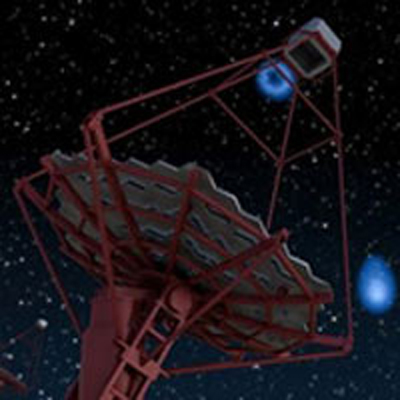Large telescope construction to study the origin of the universe
Japan is leading the way in building a large cosmic ray telescope to clarify the origin of the universe.
Large telescope was built to study the origin of the universe
On March 18, the Institute for Cosmic Ray Research of the University of Tokyo announced a plan to study the construction of a large telescope with a mirror diameter of 23 m. The telescope mirror is assembled by more than 200 hexagonal mirrors, capable of accurately monitoring both gamma rays reaching the earth.

A model of a large type cosmic ray telescope of the Cherenkov Telescope Array project
The telescope will be located in La Palma on the Canary Islands in northwestern Africa , where several large telescopes have recently been placed. Construction will begin construction in September this year; If all goes well, by November 2016 it can be completed.
The University of Tokyo's Cosmic Ray Research Institute is one of the 200 institutions in 29 countries that form the project Cherenkov Telescope Array aiming to gradually build two networks of cosmic-ray telescopes located in two. Earth hemisphere, facilitating the use of new generation cosmic ray devices to observe the whole sky.
The system of equipment Cherenkov Telescope Array will be fully operational around 2020. Scientists believe that based on the observational data of this telescope system, humans can answer the mysteries of rays the universe and the black hole, can also be observed in the initial state when the universe was born.

E-ELT- telescope model (Photo: Gizmag)
Cosmic rays are high-energy particles originating in deep space and moving to our earth at speeds close to the speed of light. Recent studies show that supernovae are a source of cosmic rays, but not the only source, and scientists are trying to explore other sources.
The University of Tokyo's Cosmic Ray Research Institute describes cosmic rays as "messengers" sent to the earth to bring to man the message transmitted from the edge of the universe. Through the analysis of cosmic rays, scientists hope to better understand the evolution of the universe.
A University of Tokyo researcher said that the discovery of cosmic rays and black holes requires a lot of time, while expressing hope to be able to use the aforementioned giant telescopes to prove the reasons. related theory and finally answer those mysteries.
- Very Large Telescope: The pure eyes of humanity look at the universe
- Russia dropped the telescope into Lake Baikal, discovered dark matter
- Turn on 'green light' for the world's largest telescope project
- NASA builds the world's most powerful telescope
- The MWA telescope started observing the universe
- Microscope and telescope, which is more
- The most terrible telescope starts
- The telescope finds out the first moment of the universe
- Commencement of the world's largest telescope project in Chile
- New hypothesis of cosmic formation
- Chile started construction of the world's largest telescope
- China will build the second giant telescope to find aliens
 Norway built the world's tallest wooden tower
Norway built the world's tallest wooden tower Kremlin
Kremlin Ashurbanipal: The oldest royal library in the world
Ashurbanipal: The oldest royal library in the world Decoding the thousand-year construction of Qin Shihuang shocked the world
Decoding the thousand-year construction of Qin Shihuang shocked the world